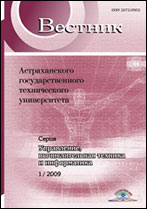|
|
Vestnik of Astrakhan State Technical University. Series: Management, Computer Sciences and Informatics, 2016, Number 2, Pages 60–72
(Mi vagtu431)
|
 |
|
 |
This article is cited in 2 scientific papers (total in 2 papers)
MATHEMATICAL MODELING
Algorithms ensuring the real conditions of multiplicity in the microbiological synthesis processes at the given dilution rate
Yu. L. Gordeevaa, N. V. Menshutinab, E. L. Gordeevab, Yu. A. Komissarovb
a K.I. Skryabin Moscow State Academy of Veterinary Medicine and Biotechnology
b D. Mendeleev University of Chemical Technology of Russia
Abstract:
The algorithms are developed and the results of calculating the steady state parameters for real conditions of multiplicity, taking into account the technological limitations and requirements, are presented. The algorithms include the assessment of necessary conditions of occurrence of multiplicity and the assessment of the parameters of the steady states in the context of multiple for the given dilution rate. Two algorithms focused on two types of technological formulation of the problem are considered. According to the first case the value of productivity on the target component $\mathcal{Q}_p$ is known. The value of productivity is defined from the condition $\mathcal{Q}_p < \max\mathcal{Q}_p$, where $\max\mathcal{Q}_p$ — previously computed value of productivity in optimal conditions. Thus, the first algorithm includes the part of the calculation of the maximum values of productivity. According to the second case the parameters of the first stationary state are known to compute the parameters of the second stationary state for the same values of productivity. Thus, it is necessary to calculate the coordinate of the optimal state $S_f^{\mathrm{opt}}$. The numerical results of the algorithms have been obtained. For the first algorithm for the dilution rate $D = 0.15$ h$^{-1} : \max\mathcal{Q}_p = 4,061$ g/(l$\cdot$h); $\mathcal{Q}_p = 3.5$ g/(l$\cdot$h); the first stationary state: $S_f^1 = 30.116$ g/l; $S^1 = 13.606$ g/l; $X^1 = 6,604$ g/l; $P^1 = 23.333$ g/l; the second stationary state: $S_f^2 = 18,450$ g/l; $S^2 = 1.940$ g/l; $X^2 = 6,604$ g/l; $P ^2 = 23.333$ g/l. It is noted that the stationary state differ by only two parameters, namely $S_f$ and $S$. A similar calculation is performed for $D = 0.26$ h$^{-1}$. According to the second algorithm the calculation is executed for $D = 0,15$ h$^{-1}$: the limit value $S_f = 47,848$ g/l; $S_f^{\mathrm{opt}}= 24.296$ g/l; the first stationary state obtained for $S_f^1 = 32,99$ g/l: $S^1 = 18,839$ g/l; $X^1 = 5,66$ g/l; $P^1 = 20,0$ g/l; $\mathcal{Q}_p = 3.0$ g/(l$\cdot$h); the second stationary state obtained for $S_f^2 = 15.55$ g/l: $S^2 = 1,401$ g/l; $X^2 = 5,66$ g/l; $P^2 = 20,0$ g/l; $\mathcal{Q}_p = 3.0$ g/(l$\cdot$h). Similar calculation is made for the case where the first stationary state determined by the value of $S_f^1 = 20.0$ g/l.
Keywords:
biotechnological processes, microbiological synthesis, multiplicity, algorithms of multiplicity ensuring, steady state, dilution rate, productivity.
Received: 07.02.2016
Citation:
Yu. L. Gordeeva, N. V. Menshutina, E. L. Gordeeva, Yu. A. Komissarov, “Algorithms ensuring the real conditions of multiplicity in the microbiological synthesis processes at the given dilution rate”, Vestn. Astrakhan State Technical Univ. Ser. Management, Computer Sciences and Informatics, 2016, no. 2, 60–72
Linking options:
https://www.mathnet.ru/eng/vagtu431 https://www.mathnet.ru/eng/vagtu/y2016/i2/p60
|

| Statistics & downloads: |
| Abstract page: | 110 | | Full-text PDF : | 29 | | References: | 29 |
|




 Contact us:
Contact us: Terms of Use
Terms of Use
 Registration to the website
Registration to the website Logotypes
Logotypes








 Citation in format
Citation in format 
